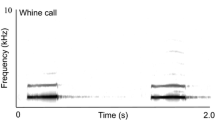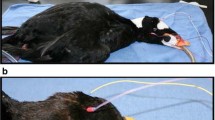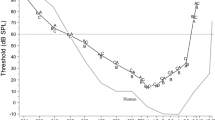Abstract
While odontocetes do not have an external pinna that guides sound to the middle ear, they are considered to receive sound through specialized regions of the head and lower jaw. Yet odontocetes differ in the shape of the lower jaw suggesting that hearing pathways may vary between species, potentially influencing hearing directionality and noise impacts. This work measured the audiogram and received sensitivity of a Risso’s dolphin (Grampus griseus) in an effort to comparatively examine how this species receives sound. Jaw hearing thresholds were lowest (most sensitive) at two locations along the anterior, midline region of the lower jaw (the lower jaw tip and anterior part of the throat). Responses were similarly low along a more posterior region of the lower mandible, considered the area of best hearing in bottlenose dolphins. Left- and right-side differences were also noted suggesting possible left–right asymmetries in sound reception or differences in ear sensitivities. The results indicate best hearing pathways may vary between the Risso’s dolphin and other odontocetes measured. This animal received sound well, supporting a proposed throat pathway. For Risso’s dolphins in particular, good ventral hearing would support their acoustic ecology by facilitating echo-detection from their proposed downward oriented echolocation beam.







Similar content being viewed by others
Abbreviations
- AEP:
-
Auditory evoked potential
- FFT:
-
Fast Fourier transform
- rms:
-
Root mean square
References
Au WWL (1993) The sonar of dolphins. Springer, New York
Au WWL, Moore PWB, Pawloski DA (1988) Detection of complex echoes in noise by an echolocating dolphin. J Acoust Soc Am 83:662–668
Brill RL, Harder PJ (1991) The effects of attenuating returning echolocation signals at the lower jaw of a dolphin (Tursiops truncatus). J Acoust Soc Am 89:2851–2857
Brill RL, Moore PWB, Dankiewicz LA (2001) Assessment of dolphin (Tursiops truncatus) auditory sensitivity and hearing loss using jawphones. J Acoust Soc Am 109:1717–1722
Bullock TH, Grinnell AD, Ikezono F, Kameda K, Katsuki Y, Nomoto M, Sato O, Suga N, Yanagisava K (1968) Electrophysiological studies of the central auditory mechanisms in cetaceans. Z Vergl Physiol 59:117–156
Castellote M, Mooney TA, Hobbs R, Quackenbush L, Goetz C, Gaglione E (2014) Baseline hearing abilities and variability in wild beluga whales (Delphinapterus leucas). J Exp Biol 217:1682–1691
Cook MLH, Verela RA, Goldstein JD, McCulloch SD, Bossart GD, Finneran JJ, Houser DS, Mann DA (2006) Beaked whale auditory evoked potential hearing measurements. J Comp Physiol A 192:489–495
Cranford TW, Krysl P, Hildebrand JA (2008) Acoustic pathways revealed: simulated sound transmission and reception in Cuvier’s beaked whale (Ziphius cavirostris). Bioinspir Biomimet 3:1–10
Cranford TW, Trijoulet V, Smith CR, Krysl P (2013) Validation of a vibroacoustic finite element model using bottlenose dolphin simulations: the dolphin biosonar beam is focused in stages. Bioacoustics 23:1–34
Finneran JJ, Houser DS (2006) Comparison of in-air evoked potential and underwater behavioral hearing thresholds in four bottlenose dolphins (Tursiops truncatus). J Acoust Soc Am 119:3181–3192
Houser DS, Finneran JJ (2006) Variation in the hearing sensitivity of a dolphin population determined through the use of evoked potential audiometry. J Acoust Soc Am 120:4090–4099
Houser DS, Finneran J, Carder D, Bonn WV, Smith C, Hoh C, Mattrey R, Ridgway S (2004) Structural and functional imaging of bottlenose dolphin (Tursiops truncatus) cranial anatomy. J Exp Biol 207:3657–3665
Houser DS, Gomez-Rubio A, Finneran JJ (2008) Evoked potential audiometry of 13 Pacific bottlenose dolphins (Tursiops truncatus gilli). Mar Mamm Sci 24:28–41
Johnson CS (1967) Sound detection thresholds in marine mammals. In: Tavolga WN (ed) Marine bioacoustics. Pergamon Press, New York, pp 247–260
Johnson CS (1968) Relation between abolute threshold and duration of tone pulse in the bottlenosed porpoise. J Acoust Soc Am 43:737–763
Kastelein RA, Bunskoek P, Hagedoorn M, Au WWL, de Haan D (2002) Audiogram of a harbor porpoise (Phocoena phocoena) measured with narrow-band frequency-modulated signals. J Acoust Soc Am 112:334–344
Ketten DR (1992) The marine mammal ear: specializations for aquatic audition and echolocation. In: Webster DB, Fay RJ, Popper AN (eds) The evolutionary biology of hearing. Springer, New York, pp 717–750
Ketten DR, Williams C, Mooney TA, Matassa K, Patchett K (2011) In vivo measures of hearing in seals via Auditory Evoked Potentials (AEP), Otoacoustic Emissions (OAE), and Computerized Tomography (CT). J Acoust Soc Am 129:2431
Leatherwood S, Perrin WF, Kirby V, Hubbs CL, Dahlheim M (1980) Distribution and movements of Risso’s dolphin, Grampus griseus, in the eastern North Pacific. Fish Bull 77:951–963
Li S, Wang K, Wang D, Akamatsu T (2005) Echolocation signals of the free-ranging Yangtze finless porpoise (Neophocaena phocaenoides asiaeorientalis). J Acoust Soc Am 117:3288–3296
Madsen PT (2005) Marine mammals and noise: problems with root mean square sound pressure levels for transients. J Acoust Soc Am 117:3952–3957
Mann D, Hill-Cook M, Manire C, Greenhow D, Montie EW, Powell J, Wells R, Bauer G, Cunningham-Smith P, Lingenfelser R, Jr RD, Stone A, Brodsky M, Stevens R, Kieffer G, Hoetjes P (2010) Hearing loss in stranded Odontocete Dolphins and Whales. PLoS One 5:e13824
Møhl B, Au WWL, Pawloski JL, Nachtigall PE (1999) Dolphin hearing: relative sensitivity as a function of point of application of a contact sound source in the jaw and head region. J Acoust Soc Am 105:3421–3424
Mooney TA, Nachtigall PE, Yuen MML (2006) Temporal resolution of the Risso’s dolphin, Grampus griseus, auditory system. J Comp Physiol A 192:373–380
Mooney TA, Nachtigall PE, Castellote M, Taylor KA, Pacini AF, Esteban J-A (2008) Hearing pathways and directional sensitivity of the beluga whale, Delphinapterus leucas. J Exp Mar Biol Ecol 362:108–116
Mooney TA, Nachtigall PE, Breese M, Vlachos S, Au WWL (2009) Predicting temporary threshold shifts in a bottlenose dolphin (Tursiops truncatus): the effects of noise level and duration. J Acoust Soc Am 125:1816–1826
Mooney TA, Li S, Ketten DR, Wang K, Wang D (2011) Auditory temporal resolution and evoked responses to pulsed sounds for the Yangtze finless porpoises (Neophocaena phocaenoides asiaeorientalis). J Comp Physiol A 197:1149–1158
Mooney TA, Yamato M, Branstetter BK (2012) Hearing in cetaceans: from natural history to experimental biology. Adv Marine Biol 63:197–246
Mooney TA, Li S, Ketten DR, Wang K, Wang D (2014) Hearing pathways in the Yangtze finless porpoise, Neophocaena asiaeorientalis asiaeorientalis. J Exp Biol 217:444–452
Nachtigall PE, Au WWL, Pawloski J, Moore PWB (1995) Risso’s dolphin (Grampus griseus) hearing thresholds in Kaneohe Bay, Hawaii. In: Thomas JA, Nachtigall PE, Kastelein RA (eds) Sensory systems of aquatic mammals. DeSpil, Woerden, pp 49–53
Nachtigall PE, Yuen MML, Mooney TA, Taylor KA (2005) Hearing measurements from a stranded infant Risso’s dolphin, Grampus griseus. J Exp Biol 208:4181–4188
Nachtigall PE, Mooney TA, Taylor KA, Yuen MML (2007) Hearing and auditory evoked potential methods applied to odontocete cetaceans. Aquat Mamm 33:6–13
Nachtigall PE, Mooney TA, Taylor KA, Miller LA, Rasmussen M, Akamatsu T, Teilmann J, Linnenschidt M, Vikingsson GA (2008) Shipboard measurements of the hearing of the white-beaked dolphin, Lagenorynchus albirostris. J Exp Biol 211:642–647
Norris KS (1968) The evolution of acoustic mechanisms in odontocete cetaceans. In: Drake ET (ed) Evolution and environment. Yale University Press, New York, pp 297–324
Norris KS (1980) Peripheral sound processing in odontocetes. In: Bushnel RG, Fish JF (eds) Animal sonar systems. Plenum Press, New York, pp 495–509
Norris KS, Harvey GW (1974) Sound transmission in the porpoise head. J Acoust Soc Am 56:659–664
Philips JD, Nachtigall PE, Au WWL, Pawloski JL, Roitblat HL (2003) Echolocation in the Risso’s dolphin, Grampus griseus. J Acoust Soc Am 113:605–616
Popov VV, Supin AY, Klishin VO, Tarakanov MB, Plentenko MG (2008) Evidence for double acoustic windows in the dolphin, Tursiops truncatus. J Acoust Soc Am 123:552–560
Rosset A, Spadola L, Ratib O (2004) OsiriX: an open-source software for navigating in multidimensional DICOM images. J Digital Imaging 17:205–216
Supin AY, Popov VV (2007) Improved techniques of evoked-potential audiometry in odontocetes. Aquat Mamm 33:14–23
Supin AY, Popov VV, Mass AM (2001) The sensory physiology of aquatic mammals. Kluwer Academic Publishers, Boston
Acknowledgments
The authors would like to express their gratitude to the administration, training staff and veterinary group of the Farglory Ocean Park, for their support of this project including providing animal access and care, training, schedule flexibility and assistance with data collection. They also thank Dr. Jiang Ping Wang and Dr. Lien Siang Chou for their contributions during the planning stages and their assistance in Taiwan. Various portions of this work were funded by a WHOI Interdisciplinary Award, the Office of Naval Research, and Farglory Ocean Park. We thank them for their support. This study was conducted with the approval of the Woods Hole Oceanographic Institution’s Animal Care and Utilization Committee (protocol number DRK #3).
Author information
Authors and Affiliations
Corresponding author
Rights and permissions
About this article
Cite this article
Mooney, T.A., Yang, WC., Yu, HY. et al. Hearing abilities and sound reception of broadband sounds in an adult Risso’s dolphin (Grampus griseus). J Comp Physiol A 201, 751–761 (2015). https://doi.org/10.1007/s00359-015-1011-x
Received:
Revised:
Accepted:
Published:
Issue Date:
DOI: https://doi.org/10.1007/s00359-015-1011-x




